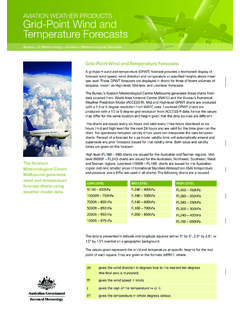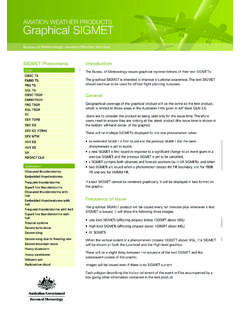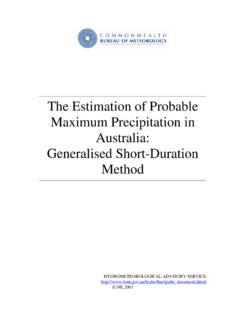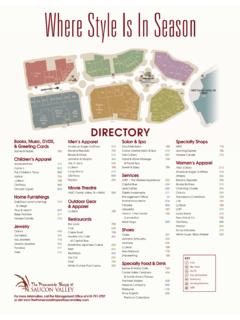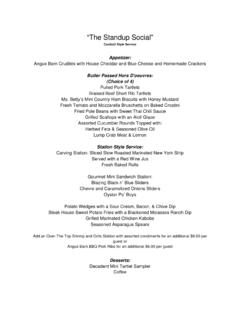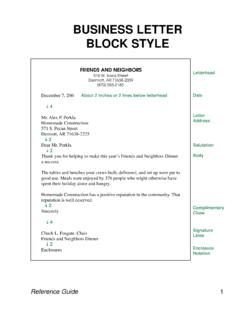Transcription of Creating a seasonal calendar toolkit - Bureau of Meteorology
1 Creating a seasonal calendar toolkit . Artwork: Laurie Nilsen Indigenous Weather Knowledge website: background and information The Indigenous Weather Knowledge (IWK) website was launched in 2002 as a joint partnership between the Bureau of Meteorology , the Aboriginal and Torres Strait Islander Commission and Monash University's Centre for Indigenous Studies. The site is a formal recognition of weather, seasonal and environmental knowledge; passed from generation to generation by Aboriginal and Torres Strait Islander people. Important: Ownership of any Aboriginal and Torres Strait Islander seasonal , weather or environmental knowledge published on the website remains with the community. A STEPPING STONE TO RECONCILIATION. The Bureau is committed to providing Aboriginal and Torres Strait Islander people and communities with a website to record and share seasonal , weather and environmental knowledge.
2 The Bureau sees the IWK. website as a way to recognise Aboriginal and Torres Strait Islander knowledge, culture and language, which has been historically marginalised from mainstream Australia. It is important to the broader reconciliation effort that we provide a space for Aboriginal and Torres Strait Islander people to share their knowledge and understanding of country with a wider Australian audience. AN IMPORTANT SOURCE OF OBSERVATIONS. The Bureau draws scientific conclusions about the world around us from short and long term observations of weather, seasons and climate. Likewise, Aboriginal and Torres Strait Islander people hand down environmental, weather and seasonal observations from generation to generation through language, stories and cultural ceremony. This is a source of valuable long-term observations spanning tens of thousands of years, which continues to inform life on country for many Aboriginal and Torres Strait Islander people.
3 A LIBRARY FOR LANGUAGE AND KNOWLEDGE. The website is a space for Indigenous communities to record and share their information in a way that faithfully represents their knowledge, culture and history of living on country. The Bureau 's Reconciliation Action plan ensures ongoing commitment to the IWK website and its availability into the future. Contact information: If you wish to find out more please email | 2. Process map for Creating a seasonal calendar The Bureau is contacted by communities and individuals wanting to record valuable Aboriginal and Torres Strait Islander seasonal , weather and environmental knowledge. Gathering this knowledge from community members and Creating a seasonal weather calendar can be a complex process as every community is unique. Follow the guide below for a general overview of what to expect when embarking on the journey of collecting and recording Aboriginal or Torres Strait Islander knowledge.
4 STEP ONE. Contact the Bureau at and let us know what community you belong to or are working with. We can help to facilitate the process and guide you through the process of Creating an IWK seasonal calendar endorsed and supported by community. STEP TWO. Talk with the community's Elders council or committee to ensure support for the sharing of Aboriginal or Torres Strait Islander knowledge with a wide Australian audience. It is important to remember that some information may be culturally sensitive, this is why approval must be given by Elders representation the Traditional Owners before publication. STEP THREE. Once approval to collect, record and share knowledge has been granted by community Elders and provided to the Bureau , sit down with knowledge holders and talk about the seasons , the weather and environmental changes that occur throughout the year.
5 With this information recorded, you are now ready to construct your seasonal calendar . Bureau staff are happy to assist with organising and recording information and any questions you may have about the process. Following this, work with the Bureau to develop a visual representation of the seasons . Check the IWK website to get an idea on how your community may want to display their seasonal information. STEP FOUR. The final content must be given to an Aboriginal or Torres Strait Islander lands council, corporation or committee representing the Traditional Owners for formal endorsement. Following endorsement the content will be uploaded onto the IWK website by staff at the Bureau . | 3. seasonal calendar templates Using a template when Creating your communities seasonal overview, allows the Bureau 's design and digital staff to create a webpage.
6 A typical IWK webpage includes all seasonal , weather and environmental information, links to community organisations, acknowledgments and any graphics or images provided by the community or created by the Bureau 's design team. The following are examples for the Noongar and Maung seasonal calendars found in the IWK website. They are included to illustrate differences in community calendars. Thanks to the Maung and Noongar communities for participating in the IWK website. ON THE PAGE. Each season in a calendar has an individual section further down the webpage that can contain additional information this may include: In-depth information on weather patterns seen during a season;. Cultural activities typically carried out during a particular season;. Hunting and food availabilities during; and Changes in flora and fauna that indicate the passing of seasons .
7 Some communities prefer not to include additional information however, provided with the table such as the one above the Bureau can create a graphical representation of the calendar to accompany the page. | 4. EXAMPLE ONE: THREE SEASON calendar . Please note: The examples shown in this document are a guide based on other seasonal calendars submitted to the IWK website. The Bureau encourages communities who may have a different approach than the examples shown to contact to discuss how we can work together to create a seasonal calendar that best represents your community. Western months Western months Western months ( January April). Name of Season Name of Season Name of Season Description Description Description Additional Information Additional Information Additional Information TEMPLATE ONE: THREE SEASON calendar .
8 | 5. EXAMPLE TWO: SIX SEASON calendar . Western months ( January Western months Western months Western months Western months Western months February). Name of Season Name of Season Name of Season Name of Season Name of Season Name of Season Description Description Description Description Description Description Additional Additional Additional Additional Additional Additional Information Information Information Information Information Information TEMPLATE TWO: SIX SEASON calendar . | 6. EXAMPLE THREE: COMPLEX seasonal calendar . Some communities may not fit the a standard seasonal template, as provided on page 5 and 6, but might have a core complex system of seasons and sub- seasons . The structure of a Indigenous seasonal calendar is based on the stories and knowledge passed down from generation to generation and the IWK website reflects this diversity by being as flexible as possible in how to present the information.
9 The following is an example template of a more complex seasonal calendar . It has three overarching seasons , imagined as a dry, wet and build-up season, with six sub- seasons . Western months Western months Western months ( January April). Name of Season Name of Season Name of Season Description Description Description Sub-season Sub-season Sub-season Sub-season Sub-season Description Description Description Description Description Additional Information Additional Information Additional Information TEMPLATE THREE: COMPLEX seasonal calendar . Please note: In some cases the table style format of seasonal information may not be suitable;. the Bureau can work with communities to create a layout that better reflects the knowledge and language. | 7. seasonal WHEEL. Provided with a seasonal template such as the one below the Bureau can create a graphical representation of the calendar .
10 Text and photographs copyright Maung language contributors and Bureau of Meteorology Internal artwork copyright Ceredwyn Ealanta Cover and footer artwork by Laurie Nilsen. | 8.



